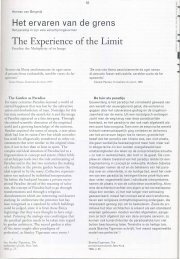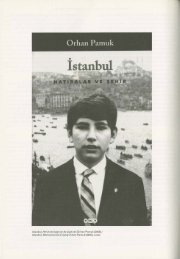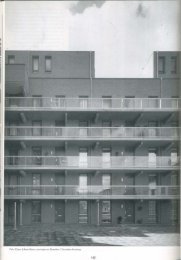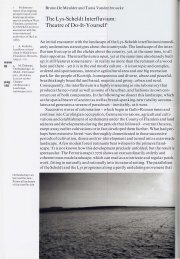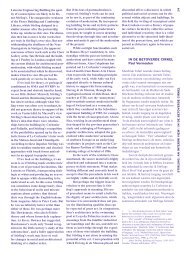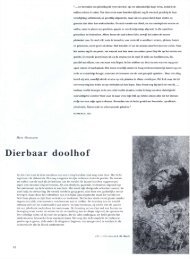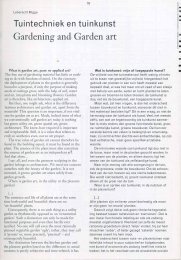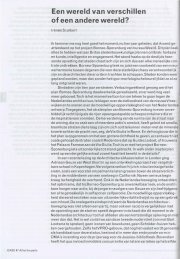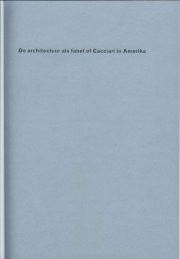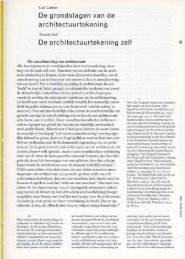Download PDF, 20 pages, 7.98 MB - Oase
Download PDF, 20 pages, 7.98 MB - Oase
Download PDF, 20 pages, 7.98 MB - Oase
Create successful ePaper yourself
Turn your PDF publications into a flip-book with our unique Google optimized e-Paper software.
Finite orders and the art<br />
of everyday inhabitation<br />
The IIunstanton School by<br />
Alison and Peter Smithson<br />
Traditionally the fine arts depend on the popular arts<br />
for their vitality, and the popular arts jar their<br />
respectability. It has been said that things hardly 'exist'<br />
b({[ore the fine artist has made use of them; they are<br />
simply part of the unclassified background material<br />
against which we pass our lives. The traniformation<br />
from everyday object to fine art manifestation happens<br />
in many ways: the object can be discovered- objet<br />
trouve of art brut - the object itself remaining the<br />
same; ( .. ) or the object can be used as a jumping off<br />
point and is itself traniformed.<br />
Alison and Peter Smithson, Without Rhetoric, 1972<br />
Can buildings engage with the essentially non-archi<br />
tectural phenomena of everyday life, except by provid<br />
ing a more or less adequate background? For prewar<br />
Functionalism this question seemed to have found a<br />
definitive answer which relied on an understanding<br />
of function as a scientifically defined necessity. In<br />
spite of the various, often contradicting ideas as to<br />
how function and form might be related, the notion of<br />
function provided quantifiable parameters for archi<br />
tectural design in an industrial society. Architecture<br />
played an active part in a cultural and political project<br />
the def inition of which was as clear as it was bold;<br />
modern architecture as a means to achieve minimum<br />
standards for every individual independent of his or<br />
her social position.<br />
The notion of standard was an essential condition<br />
for achieving an equal distribution of means of the<br />
consumption; it did not answer the question how<br />
architecture might express the agenda for a social and<br />
democratic society, nor did it necessarily care much<br />
for the existing cultural patterns of the social classes<br />
for which it catered. The realism and non-judgemen<br />
tal interest in the everyday life of the urban working<br />
classes which we find in, say, Alfred Doblin's novel<br />
Berlin Alexanderplatz is absent in the discourse of<br />
modern architecture. The culture of everday life was<br />
the product of a utopian project, mediated through the<br />
architectural vocabulary of Functionalism; not a rich<br />
and valuable source of inspiration or field of research.<br />
When building started in Europe after the war it<br />
seemed for a short time that the programme of the<br />
prewar avantgardes provided the guidelines along<br />
which the gargantuan task of reconstructing the cities<br />
could be fulfilled. Yet, within less than a decade the<br />
fault-lines, which would eventually undermine the<br />
delicate consensus that had characterised modern<br />
Christoph Grafe<br />
67<br />
Eindige ordes en de kunst van<br />
de alledaagse bewoning<br />
De Hunstanton School van<br />
Alison en Peter Smithson<br />
Traditionall'h the fine arts depend on the popular arts for their<br />
vitalil'h and the popular arts for their respectability. It has<br />
been said that things hardly 'exist' before the fine artist has<br />
made use of them; they are simply part of the unclassified<br />
background material against which we pass our lives. The<br />
transformation from everyday object to fine art manifestation<br />
happens in many ways: the object can be discovered- objet<br />
trouve or art brut- the object itself remaining the same; ( .. .)<br />
or the object can be used as a jumping off point and is itself<br />
transformed.<br />
Alison en Peter Smithson, Without Rhetoric, 1972<br />
Kunnen gebouwen zich op een andere manier dan als min<br />
of meer geschikte achtergrond verhouden tot de uiteindelijk<br />
niet-architectonische fenomenen van het alledaagse Ieven?<br />
Het vooroorlogse functionalisme leek op deze vraag een<br />
definitief antwoord te hebben gevonden; een antwoord dat<br />
steunde op het begrip van de functie voortkomend uit een<br />
wetenschappelijk gedefinieerde noodzaak. Ondanks het feit<br />
dat er vele, elkaar vaak tegensprekende ideeen bestonden<br />
over hoe vorm en functie gerelateerd konden zijn, voorzag<br />
de functie in kwantificeerbare parameters voor architecto<br />
nisch ontwerpen in een industriele samenleving. Architec<br />
tuur speelde een actieve rol in een culturele en politieke<br />
agenda. De omschrijving van deze agenda was even helder<br />
als uitgesproken: moderne architectuur was een middel om<br />
minimumstandaards te bereiken voor ieder individu,<br />
onafhankelijk van zijn of haar sociale positie.<br />
De notie van een standaard vormde een essentiele voor<br />
waarde voor het bereiken van een rechtvaardige distributie<br />
van consumptiemiddelen; ze gaf geen antwoord op de vraag<br />
op welke manier architectuur de agenda voor een sociale en<br />
democratische samenleving zou kunnen uitdrukken, en<br />
evenmin werd er rekening gehouden met de bestaande<br />
culturele patronen van de sociale klassen waarvoor men<br />
het opnam. Het realisme en de onbevooroordeelde belang<br />
stelling voor het alledaagse Ieven van de gewone stadsbe<br />
woner die we bijvoorbeeld in Alfred Doblins roman Berlin<br />
Alexanderplatz vinden, zijn afwezig in het discours van de<br />
moderne architectuur. De cultuur van het alledaagse Ieven<br />
was eerder het product van de utopische onderneming,<br />
waarbij de architectonische taal van het functionalisme als<br />
bemiddelaar optrad, niet als een rijke en waardevolle bron<br />
van inspiratie of een veld van onderzoek.<br />
Toen men na de oorlog weer begon te bouwen, leek het<br />
voor een korte periode erop dat de uitgangspunten van de<br />
vooroorlogse avant-gardes nog steeds bruikbaar waren om<br />
de enorme taak van de wederopbouw van de Europese<br />
steden te realiseren. Binnen tien jaar werden echter de<br />
OASE # 49/50 1998




